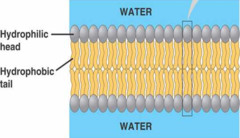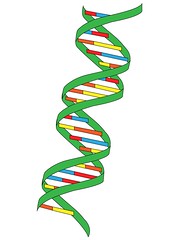Campbell Biology Chapter 5 Flashcards
Terms : Hide Images [1]
| 11234655303 | macromolecule | a large macromolecule formed by the joining of smaller molecules( subunit), usually by a dehydration chemical reaction. | 0 | |
| 11234655338 | Four classes of biological macromolecules | Proteins, carbohydrates, nucleic acids, lipids | 1 | |
| 11234655304 | polymer | a long molecule consisting of many similar or identical monomers linked together by covalent bonds. | 2 | |
| 11234655305 | monomer | the subunit that serves as the building block of a polymer. | 3 | |
| 11234655306 | dehydration synthesis | a chemical reaction in which two molecules become covalently bonded to each other with the removal of a water molecule. |  | 4 |
| 11234655307 | hydrolysis | a chemical reaction that breaks bonds between two molecules by the addition of water; functions in dis-assembly of polymers to monomers. |  | 5 |
| 11234655308 | protein | a macromolecule consisting of one or more polypeptides chains made up amino acids folded and coiled into a specific three-dimensional structure. | 6 | |
| 11234655339 | Functions of proteins | structural support, catalyst, transport, defense, movement, regulation | 7 | |
| 11234655309 | amino acid | an organic molecule possessing both a carboxyl and an amino group. The monomers of polypeptides. There are 20 different forms. Distinguished by side chains. |  | 8 |
| 11234655310 | peptide bond | the linkage between amino acids forming a covalent bond between the carboxyl group on one amino acid and the amino group on another, formed by a dehydration reaction. |  | 9 |
| 11234655340 | denaturation | loss of a proteins normal 3D structure; can possibly be caused by pH and temperature changes which affect the ionic bonds, hydrogen bonds & hydrophilic interactions |  | 10 |
| 11234655311 | enzyme | a macromolecule serving as a catalyst, a chemical agent that increases the rate of a reaction without being consumed by the reaction. most of them are proteins. | 11 | |
| 11234655312 | carbohydrate | a sugar (monosaccharide) or one of its dimers (disaccharides) or polymers (polysaccharides). Primarily C, H and O. | 12 | |
| 11234655341 | What are the functions of carbohydrates | function as energy source & structure support; examples: simple sugars, and complex polysacchrides, structural suppport examples: cell wall in pant cells, chitin in insects. | 13 | |
| 11234655313 | monosaccharide | the simplest carbohydrate, active alone or serving as a monomer for disaccharides and polysaccharides. Also called simple sugars, they have formulas that are generally some multiple of CH2O (1:2:1). |  | 14 |
| 11234655314 | disaccharide | a double sugar, consisting of two monosaccharides joined by a glycosidic linkage formed by a dehydration reaction. |  | 15 |
| 11234655315 | polysaccharide | a polymer of many monosaccharides, formed by dehydration reactions. |  | 16 |
| 11234655316 | starch | a storage polysaccharide in plants, consisting entirely of glucose monomers joined by x glycosidic linkages. Used for energy storage. | 17 | |
| 11234655317 | glycogen | an extensively branched glucose storage polysaccharide found in the liver and muscle of animals; the animal equivalent of starch. | 18 | |
| 11234655318 | cellulose | a structural polysaccharide of plant cell walls, consisting of glucose monomers joined by B glycosidic linkages. A type of plant starch. | 19 | |
| 11234655319 | lipids | any of a group of large biological molecules, including fats, phospholipids, and steroids, that mix poorly, if at all, with water (hydrophobic). No true monomers. | 20 | |
| 11234655342 | What are the three types of lipids? | fats/oils, phospholipids & steroids | 21 | |
| 11234655320 | fat/oil | a lipid consisting of three fatty acids lined to one glycerol molecule; also called a triacylglycerol or triglyceride. Function as energy storage. | 22 | |
| 11234655321 | saturated | a fatty acid in which all carbons in the hydrocarbon tail are connected by single bonds, thus maximizing the number of hydrogen atoms that are attached to the carbon skeleton. |  | 23 |
| 11234655322 | unsaturated | a faty acid that has one or more double bonds betwen carbons in the hydrocarbon tail. such bonding reduces the number of hydrogen atoms attached to the carbon skeleton. |  | 24 |
| 11234655323 | fatty acid | a carboxylic acid with a long carbon chain. Vary in length and __________ linked to a glycerol molecule form a fat molecule, also called triglyceride. | 25 | |
| 11234655324 | chitin | a structural polysaccharide, consisting of amino sugar monomers, found in many fungal cell walls and in the exoskeletons of all arthropods. | 26 | |
| 11234655325 | trans fat | an unsaturated fat, formed artificially during hydrogenation of oils, containing one or more trans double bonds. |  | 27 |
| 11234655326 | phospholipid | a lipid made up of glycerol joined to two fatty acids and a phosphate group. The hydrocarbon chains of the fatty acids act as nonpolar hydrophobic tails, while the rest of the molecule acts s a polar, hydrophilic head. They form bilayers that function as biological membrane. |  | 28 |
| 11234655343 | phospholipid bilayer | function as membranes |  | 29 |
| 11234655327 | steroid | a type of lipid characterized by a carbon skeleton consisting of four fused rings with various chemical groups attached. Function as part of membranes or hormones. |  | 30 |
| 11234655328 | catalyst | a chemical agent that selectively increases the rate of a reaction without being consumed by the reaction. | 31 | |
| 11234655329 | hydrophobic | a type of weak chemical interaction caused when molecules that do not mix with water coalesce to exclude water. | 32 | |
| 11234655330 | polypeptide | a polymer of many amino acids linked together by peptide bonds. | 33 | |
| 11234655331 | nucleic acid | a polymer (polynucleotide) consisting of many nucleotide monomers; serves as a blueprint for proteins and, through the actions of proteins, for all cellular activities. the two types are DNA and RNA. | 34 | |
| 11234655344 | functions of nucleic acid | functions as storage, transmission & use of genetic material | 35 | |
| 11234655332 | nucleotide | the building block of a nucleic acid, consisting of a five-carbon sugar covalently bonded to a nitrogenous base and one or more phosphate groups. |  | 36 |
| 11234655333 | polynucleotide | a polymer consisting of many nucleotide monomers in a chain. The nucleotides can be those of DNA or RNA. |  | 37 |
| 11234655345 | RNA | transmission of information, consists of monomers with a ribose sugar and nitrogenous bases cytosine (C), guanine (G), adenine (A) & uracil (U). Single stranded. |  | 38 |
| 11234655334 | DNA | a nucleic acid molecule, usually a double-stranded helix, in which each polynucleotide strand consists of nucleotide monomers with a deoxyribose sugar and the nitrogenous bases adenine (A), cytosine (C), guanine (G), and thymine (T); capable of being replicated and determining the inherited structure of a cell's proteins. |  | 39 |
| 11234655335 | deoxyribose | the sugar component of DNA nucleotides, having one fewer hydroxyl group than ribose, the sugar component of RNA nucleotides. |  | 40 |
| 11234655336 | ribose | the sugar component of RNA nucleotides. |  | 41 |
| 11234655337 | double helix | the form of native DNA, referring to its two adjacent antiparallel polynucleotide strands wound around an imaginary axis into a spiral shape. |  | 42 |
| 11234655346 | amphipathic | Definition. adjective. (1) Pertains to a molecule containing both polar (water-soluble) and nonpolar (not water-soluble) portions in its structure. (2) Of, or relating to, a molecule having hydrophobic and hydrophilic regions | 43 |
